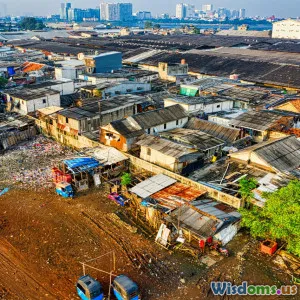
How Neighborhood Design Predicts Local Crime Rates
9 min read Explore how neighborhood design impacts local crime rates through urban planning, environmental factors, and social interactions. (0 Reviews)
How Neighborhood Design Predicts Local Crime Rates
Crime isn't an isolated phenomenon; it's intricately linked to the spaces where we live. Urban planners, criminologists, and sociologists agree: the way a neighborhood is designed plays a crucial role in influencing its crime rates. But how exactly does the layout of streets, public spaces, and homes predict levels of safety or danger? This article embarks on an in-depth exploration of how neighborhood design impacts local crime, supported by research, real-world examples, and proven urban planning strategies.
The Foundation: Why Neighborhood Design Matters
Neighborhood design refers to the physical configuration of residential areas, including street layouts, building arrangements, lighting, green spaces, and public amenities. These elements collectively influence behavior, interaction, and community cohesion, which in turn affect crime prevalence.
In 1972, architect Oscar Newman introduced the concept of 'defensible space', emphasizing how thoughtful design could empower residents to naturally deter crime by fostering territoriality and surveillance. This foundational theory catalyzed a stronger focus on the link between the built environment and crime control.
The Role of Visibility and Natural Surveillance
One of the core principles in reducing crime through design is enhancing natural surveillance—ensuring that public and semi-private spaces are visible to residents and passersby. Streets with clear sightlines and well-lit public areas discourage criminal activity by increasing the perceived risk of detection.
A study of Chicago neighborhoods revealed that areas with better street lighting experienced 39% fewer assaults at night than poorly lit areas. This underscores that even subtle design features, like streetlamps or window placements, profoundly impact perceived and actual safety.
Street Layouts: Grid vs. Cul-de-Sac
The design of street networks shapes both mobility and social interaction. Connected grid-style streets encourage more foot traffic, casual encounters, and “eyes on the street,” as Jane Jacobs famously termed it. In contrast, cul-de-sacs and dead-ends limit through traffic, which can be both a boon and a bane for crime.
- Grids: Encourage pedestrian movement and activity, which can deter crime but might provide easier escape routes for offenders.
- Cul-de-Sacs: Restrict access points, potentially lowering certain crimes like burglary but possibly reducing natural surveillance.
A 2017 study from the University of Utah found that neighborhoods with complex, defensible designs such as gated communities tended to experience lower burglary rates, though social isolation in such areas can offset some benefits.
Social Cohesion and Mixed-Use Design
Physical design influences social behavior; neighborhoods designed to encourage interaction among residents often witness lower crime. Social ties generate informal social control, a form of community-led policing.
Mixed-Use Developments
Neighborhoods integrating residential, commercial, and recreational spaces foster a continuous flow of people during various times of the day, which increases surveillance and reduces the chances of crime going unnoticed.
For example, Portland, Oregon has long embraced mixed-use development with community spaces, businesses, and residences combined. According to Portland's urban safety reports, neighborhoods with mixed-use development experience a 20% lower rate of street crime than fully residential counterparts.
Public Spaces and Green Areas
Access to communal parks and open areas also plays a double role. Well-maintained parks attract positive activity, creating opportunities for community bonding and supervision. Conversely, abandoned or poorly designed green spaces can become hotspots for crime.
In New York City's NYC Parks Department initiatives, revitalizing abandoned parks with improved lighting, clear sightlines, and community programming reduced crime incidents by up to 60% in adjacent neighborhoods.
The Dark Side: Poor Design and Crime Hotspots
Not all design elements deter crime. Certain neighborhood features inadvertently facilitate it:
Overcrowding and Blight
Poorly maintained housing and overcrowded neighborhoods often experience higher crime rates. Blighted properties and empty lots can serve as hideouts and attract criminal behavior.
A classic example is Detroit, where high vacancy rates and abandoned buildings have been strongly correlated with increased property crime and violent offenses, as documented by the Detroit Blight Removal Task Force.
Dead Zones and Unmonitored Areas
Designs producing “dead zones”—areas with little natural surveillance—provide sheltering opportunities for illicit behavior. For future planners, eliminating blind spots in parks, underpasses, and street corners has become a priority.
Urban Planning Strategies to Reduce Crime
The relationship between design and crime is bidirectional: while poor design can increase risks, intentional urban planning mitigates them.
Crime Prevention Through Environmental Design (CPTED)
CPTED principles advocate for layering territorial reinforcement, natural surveillance, image management, and access control to discourage crime.
Some key CPTED strategies:
- Designing buildings with windows overlooking streets and parking lots
- Incorporating secure fencing and lighting
- Limiting unmonitored entrance points
Cities like Seattle have incorporated CPTED guidelines in neighborhood developments. A 2016 review found CPTED implementations cut down local burglary rates by up to 25%.
Community Engagement and Design
A well-designed neighborhood encourages community ownership. Initiatives that involve residents in planning and maintenance often witness reduced crime rates.
For example, the neighborhood watch programs complement physical design by increasing informal social control and reporting suspicious conduct. When paired with good infrastructure, the impact is substantial.
Case Study: The Transformation of Medellín, Colombia
Once infamous for high violent crime rates, Medellín’s turnaround in the past two decades largely ties to urban design reforms.
Investment in public transportation, like cable cars to connect marginalized neighborhoods, creation of public libraries and parks, improved lighting, and pedestrian-friendly streets all helped integrate communities socially and physically.
Researchers from MIT noted crime reductions of over 50% in many of these revamped districts, attributing this to increased accessibility, visibility, and social inclusion fostered by smart neighborhood design.
Conclusion: Designing Safer Neighborhoods is Possible and Necessary
Neighborhood design is a powerful predictor of local crime rates. From street layouts fostering natural surveillance to mixed-use spaces invigorating social cohesion, the built environment shapes criminal dynamics profoundly. However, it's crucial to understand that design alone cannot eliminate crime; it must be combined with community involvement, law enforcement, and social services.
As cities expand and evolve, urban planners, policymakers, and residents have a shared responsibility to advocate for and implement evidence-based designs that foster safety, well-being, and connectedness. The path forward lies in viewing neighborhood design not merely as aesthetics or convenience but as a cornerstone of public safety and urban health.
References:
- Newman, O. (1972). Defensible Space: Crime Prevention Through Urban Design.
- Chicago Crime Commission (2019). Lighting and Crime Prevention Study.
- University of Utah, Department of Sociology (2017). Street Layout and Crime Risk Analysis.
- Portland Urban Safety Reports (2021).
- NYC Parks Department Crime Reduction Initiative (2018).
- Detroit Blight Removal Task Force Report (2020).
- MIT Urban Studies and Planning (2019). Medellín’s Urban Transformation.
For readers interested in urban safety, understanding design nuances is the first step toward building resilient, thriving communities where safety is woven into the fabric of everyday life.
Rate the Post
User Reviews
Other posts in Urban Planning
Popular Posts

















